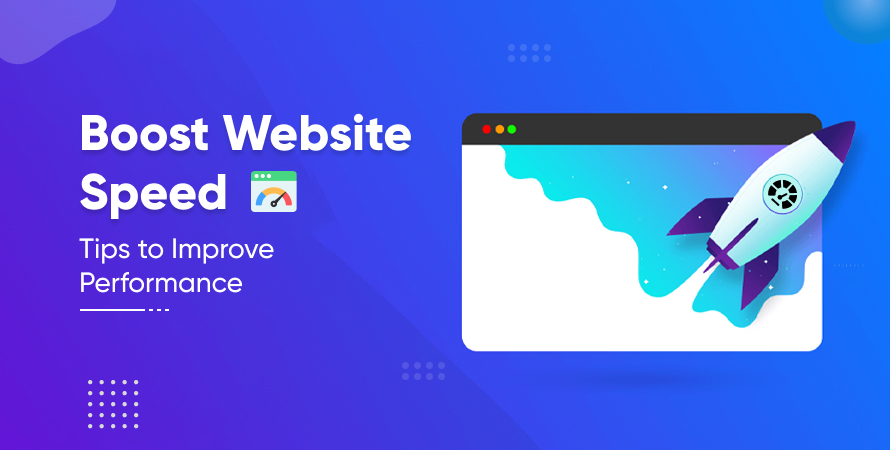Boost Website Speed: Tips to Improve Performance



Introduction
In the fast-paced world of digital consumption, your website’s loading speed is no longer just a technical concern—it’s a critical part of your user experience, Search Engine Optimization (SEO), and overall online success. Whether you’re running a blog, e-commerce store, or company website, speed can make or break your digital performance.
A fast website not only impresses visitors but also improves your rankings on search engines like Google. Slow-loading pages frustrate users, increase bounce rates, and hurt your bottom line. In fact, according to studies, even a one-second delay in load time can reduce conversions by 7%.
If your website is lagging, you’re likely losing valuable traffic and potential customers. This blog will explore everything you need to know about website speed—from what it is, why it matters, to how you can fix it. Whether you’re managing things yourself or working with a digital marketing agency, this guide will help you take actionable steps to boost performance.
What Is Website Speed?
Website speed refers to how fast your content loads and becomes interactive when someone visits your site. More technically, it includes several key performance metrics:
- Page Speed: How quickly a specific page loads.
- Site Speed: The overall performance of your entire website.
- Time to First Byte (TTFB): How quickly the server responds.
- First Contentful Paint (FCP): Time it takes for the first element (text or image) to appear.
- Largest Contentful Paint (LCP): When the main content finishes loading.
- Cumulative Layout Shift (CLS): Measures visual stability as the page loads.
- Time to Interactive (TTI): How long before the page is fully interactive.
Google uses many of these metrics, especially those under Core Web Vitals, to evaluate your site’s performance.
Why Website Speed Matters
Website speed is not just a technical number—it directly impacts user behavior, brand perception, and your position in search results. Here’s why it matters:
1. Better User Experience
Fast-loading websites offer a smoother, more pleasant experience. Users expect pages to load quickly, and a delay of even a couple of seconds can lead them to abandon your site altogether.
2. Lower Bounce Rates
The longer your page takes to load, the more likely users are to leave before exploring further. High bounce rates can damage your site’s credibility and signal to search engines that users aren’t finding value.
3. Higher SEO Rankings
Google has confirmed that webpage speed is a ranking factor. Core Web Vitals, in particular, are now a part of Google’s page experience signals. A faster site can gain a competitive edge in search engine results.
4. Increased Conversions
Speed boosts engagement and leads to higher conversions. Faster e-commerce sites report improved checkout rates and lower cart abandonment.
5. Enhanced Mobile Performance
A growing number of users access the web via mobile devices. Mobile networks often have slower speeds and less stability, making it critical to have a fast and responsive website to effectively serve these users.
Top Reasons Why Your Website Might Be Slow
Understanding why your site is underperforming is the first step in fixing it. Here are ten of the most common causes of a slow website:
1. Unoptimized Images
Large, high-resolution images that haven’t been compressed are one of the main culprits behind slow pages.
2. Too Many HTTP Requests
Each element on a web page—such as images, scripts, and stylesheets—requires an individual HTTP request. An increased number of these requests results in longer load times.
3. Render-Blocking JavaScript
JavaScript files that load before the content can block the browser from rendering the page quickly.
4. Lack of Browser Caching
If your site doesn’t use caching, returning visitors have to reload the same data every time they visit, which slows down their experience.
5. Poor Hosting Provider
Shared or low-quality hosting can result in slow server response times, especially during high-traffic periods.
6. Too Many Plugins
Using excessive or outdated plugins (especially on platforms like WordPress) can burden your site with unnecessary code and slow everything down.
7. Bloated Themes or Inefficient Code
Certain themes include excessive features and large file sizes, which contribute to longer load times. Utilizing clean and efficient code is crucial for optimal performance.
8. No Content Delivery Network (CDN)
Without a CDN, users far from your server may experience slow load times. A CDN stores content in multiple locations globally to speed up delivery.
9. Too Many Ads or Third-Party Scripts
Ad networks, social media widgets, and tracking tools can all add extra loading time if not implemented correctly.
10. Missing GZIP Compression
If your website isn’t using GZIP or Brotli compression, larger files take longer to load, especially over slow internet connections.
How to Measure Website Speed
Before you improve your site’s speed, you need to know where you stand. Several reliable tools help you measure your performance:
1. Google PageSpeed Insights
Provides comprehensive performance scores along with actionable recommendations. Additionally, it emphasizes Core Web Vitals metrics.
2. GTmetrix
Offers speed scores and waterfall charts showing how each element of your site loads.
3. Pingdom Tools
Useful for monitoring performance from different global locations.
4. WebPageTest
Gives advanced details including time to first byte and content loading timelines.
5. Lighthouse (Chrome DevTools)
Generates a comprehensive audit of your site’s speed, accessibility, and SEO directly from your browser.
When you use these tools, pay special attention to metrics like LCP, FID (First Input Delay), CLS, and overall load time.
Best Practices to Improve Website Speed and Performance
Now that you know what slows a website down and how to measure it, let’s look at proven ways to improve performance.
1. Compress and Optimize Images
Reduce image sizes without compromising quality by using efficient formats like WebP. Tools such as TinyPNG and ShortPixel compress images, which significantly improves web page’s loading speed, especially on media-heavy pages, and enhances user experience across all devices.
2. Minify CSS, JavaScript, and HTML
Clean up your code by removing spaces, comments, and redundant characters using tools like UglifyJS and CSSNano. This reduces file sizes, improves server response time, and speeds up the browser’s rendering of your website’s content.
3. Use Asynchronous JavaScript Loading
Avoid delays in page rendering by loading JavaScript files asynchronously or deferring them until after the primary content loads. This technique prevents scripts from blocking the browser’s rendering process and ensures users see content faster.
4. Enable Browser Caching
Leverage browser caching to store static resources locally on users’ devices. This way, returning visitors load your site faster without downloading all assets again, improving repeat visit performance and reducing unnecessary strain on your server.
5. Implement Lazy Loading
Lazy loading delays the loading of off-screen images and videos until users scroll near them. This reduces initial page load time, especially on image-heavy websites, and improves both user experience and performance scores on speed tests.
6. Choose a High-Quality Hosting Provider
Invest in reliable hosting such as VPS or cloud-based services to ensure fast server response times. Poor-quality hosting can bottleneck your performance, no matter how optimized your site is, especially during traffic surges or peak hours.
7. Use a Lightweight Theme
Avoid bloated or overly complex themes with excessive features. Choose streamlined, performance-focused templates that are designed to load quickly and use clean code, especially if you’re on platforms like WordPress or Shopify.
8. Limit Redirects
Minimize the use of redirects to prevent unnecessary HTTP requests that slow down your site. Use permanent redirects only when essential, and regularly audit for outdated or broken redirects that can negatively affect performance and SEO.
9. Clean Up Your Database
Over time, databases accumulate clutter such as post revisions, spam comments, and unused tables. Use tools or plugins to periodically clean and optimize your database to maintain speed, reduce server load, and improve backend performance.
10. Adopt Responsive Design
Ensure your website is mobile-friendly and adjusts seamlessly to various screen sizes. Responsive design not only improves user experience on smartphones and tablets but also contributes to better performance metrics and search engine visibility.
Tools to Help You Optimize Site Speed
Here are some top tools that can make optimizing your website performance easier:
Image Optimization Tools
- TinyPNG
- ShortPixel
- ImageOptim
Caching Solutions
- WP Rocket
- W3 Total Cache
- LiteSpeed Cache
CDNs
- Cloudflare
- StackPath
- Akamai
Performance Monitoring
- Google Analytics
- UptimeRobot
- New Relic
Code Optimization
- Webpack
- Gulp
- Autoptimize (WordPress)
How a Digital Marketing Agency Can Help
Website performance optimization isn’t always a DIY project. A digital marketing agency brings technical expertise, performance audits, and long-term strategy to the table.
Agencies can:
- Conduct in-depth site load speed and SEO audits
- Optimize code, structure, and design
- Manage hosting, CDN, and server-level settings
- Provide ongoing performance monitoring
- Integrate site speed optimization into broader SEO and marketing strategies
If you’re unsure where to begin or need expert support, collaborating with a digital marketing agency can accelerate your success.
Conclusion
Website speed plays a vital role in how users interact with your brand, how search engines rank your pages, and how effectively your website converts visitors into customers. The good news is, improving performance is achievable with the right tools, best performance practices, and a clear understanding of your site’s current state.
Whether you’re working solo or with professional support, consistent website optimization ensures better results and stronger engagement.
If you’re looking for tailored help to boost your website speed optimization and SEO performance, consider reaching out to SEO Expert New York—we specialize in fast, optimized, and growth-driven digital solutions.
Frequently Asked Questions (FAQs)
A website should ideally load in under 2 seconds. For e-commerce and conversion-focused sites, aiming for 1 to 1.5 seconds can significantly reduce bounce rates and improve user satisfaction, engagement, and overall sales performance.
Website speed should be tested at least once a month. Also, run tests after major updates, design changes, or plugin installations to ensure your site continues to load quickly and perform optimally across all devices and browsers.
Yes, website speed is a confirmed Google ranking factor. Faster-loading websites tend to perform better in search results, particularly as Google emphasizes user experience and Core Web Vitals metrics in its algorithm for both desktop and mobile rankings.
Yes, especially if the plugins are poorly coded or outdated. Too many plugins can create code bloat, increase server requests, slow loading time, and sometimes even cause security vulnerabilities or conflicts that degrade your site’s overall performance.
Lazy loading defers the loading of off-screen images and media until users scroll near them. It’s highly recommended, particularly for image-heavy sites, as it improves initial load time and enhances the browsing experience without compromising content accessibility.